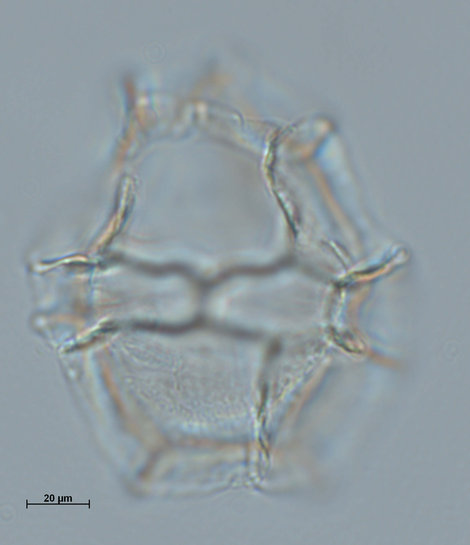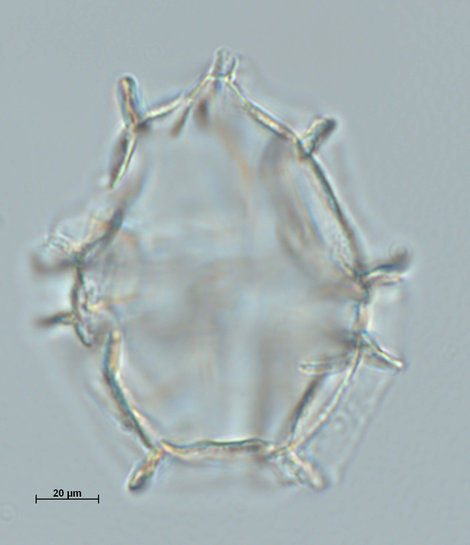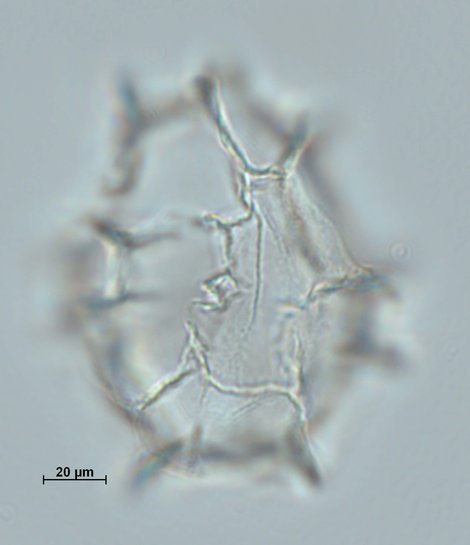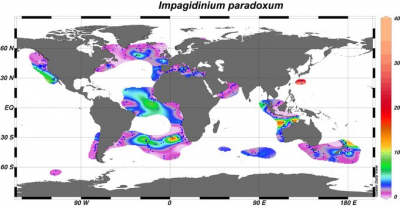Page path:
- Modern Dinocyst Key
- transparent cysts
- Paratabulation reflected by septa
- Septa intermediate height
- Impagidinium paradoxum
Impagidinium paradoxum
Zonneveld, K.A.F. and Pospelova V. (2015). A determination key for modern dinoflagellate cysts. Palynology 39 (3), 387- 407.

dorsal view
photo: Karin Zonneveld
photo: Karin Zonneveld

cross section
photo: Karin Zonneveld
photo: Karin Zonneveld

ventral view
photo: Karin Zonneveld
photo: Karin Zonneveld
Field Characteristics
Impagidinium paradoxum (Wall 1967) Stover et Evitt 1978
Field characteristics:
Small proximochorate cyst of ovoid shape, with a small apical protuberance and a microgranulate wall surface. Tabulation is defined by well-expressed low sutural septa except in the sulcal area where they are weakly developed. Archeopyle is precingular (Type P).
Dimensions: Cyst body: 28 x 31 µm; height of septa: 3 µm.
Motile affinity: Probably a cyst of Gonyaulax spp.
Stratigraphic range: Lower Miocene to Recent.
Comparison with other species:
This is one of the most difficult species to identify and it can be mistaken by some with Impagidinium patulum, Impagidinium sphaericum and Impagidinium strialatum. The septa of I. paradoxum are smooth to granulate. They are not that firm as those of I. patulum and I. aculeatum. The height of the individual septum does not vary between the triple junctions and the middle of the septa as by I. aculeatum. The granulation of the septa can be more or less distinct. Specimens with clear granulation of the septa might be misidentified as I. sphaericum, they however never have holes in their septa and both septa layers always appear connected (best visible at the triple junctions) The cell wall of I. paradoxum is microgranulate in comparison to that of I. patulum. The complete tabulation is reflected in contrast to I. strialatum.
Geographic Distribution
Geographic distribution based on :
Zonneveld et al., 2013. Atlas of modern dinoflagellate cyst distribution based on 2405 datapoints. Review of Palaeobotany and Palynology, v. 191, 1-197
Zonneveld et al., 2013. Atlas of modern dinoflagellate cyst distribution based on 2405 datapoints. Review of Palaeobotany and Palynology, v. 191, 1-197
Impagidinium paradoxum has a temperate to equatorial distribution, restricted to full-marine environments. Although it can be observed in both oligotrophic to eutrophic environments and sites that can be found in shallow-coastal to the open ocean regions, highest relative abundances of this species can be observed in the central oceans with low upper water productivity and well ventilated bottom waters.

Distribution:
The distribution of Impagidinium paradoxum is restricted to temperate to equatorial full-marine regions between the sub-tropical frontal systems of both hemispheres. Although it can be observed in coastal sites, highest relative abundances up to 34% of the association can be observed in the sub-tropical, tropical and equatorial central oceans.
Environmental parameters:
SST: 0.3 - 29.8°C (winter - spring) except for one site in the northern North Atlantic and one site in the southern South Pacific where winter and spring temperatures are below 0°C. SSS: 30.8 - 39.4 (spring - summer), [P]: 0.06 - 1.87 μmol/l, [N]: 0.04 - 25.7 μmol/l, chlorophyll-a: 0.05 - 11.5 ml/l, bottom water [O2]: > 1.0 ml/l except for two sites.
Highest relative abundances of more than 10% can be observed in regions with temperatures between 16.1 - 29.4°C (winter - summer) in oligotrophic regions where Chlorophyll-a concentrations are low. With two exceptions its distribution is restricted to sites with well-ventilated bottom waters.
Comparison with other records:
So far I. paradoxum has not been documented from regions other than the ones covered in this Atlas. In records not included in this database, highest relative abundances can be observed in sites where oligotrophic conditions prevail although I. paradoxum does not avoid mesotrophic to eutrophic environments. So far only one sediment trap study reports the production of these cysts in the western Arabian Sea where it is found at times when stratified, oligotrophic conditions in the upper water column are present (Zonneveld and Brummer, 2000).
The distribution of Impagidinium paradoxum is restricted to temperate to equatorial full-marine regions between the sub-tropical frontal systems of both hemispheres. Although it can be observed in coastal sites, highest relative abundances up to 34% of the association can be observed in the sub-tropical, tropical and equatorial central oceans.
Environmental parameters:
SST: 0.3 - 29.8°C (winter - spring) except for one site in the northern North Atlantic and one site in the southern South Pacific where winter and spring temperatures are below 0°C. SSS: 30.8 - 39.4 (spring - summer), [P]: 0.06 - 1.87 μmol/l, [N]: 0.04 - 25.7 μmol/l, chlorophyll-a: 0.05 - 11.5 ml/l, bottom water [O2]: > 1.0 ml/l except for two sites.
Highest relative abundances of more than 10% can be observed in regions with temperatures between 16.1 - 29.4°C (winter - summer) in oligotrophic regions where Chlorophyll-a concentrations are low. With two exceptions its distribution is restricted to sites with well-ventilated bottom waters.
Comparison with other records:
So far I. paradoxum has not been documented from regions other than the ones covered in this Atlas. In records not included in this database, highest relative abundances can be observed in sites where oligotrophic conditions prevail although I. paradoxum does not avoid mesotrophic to eutrophic environments. So far only one sediment trap study reports the production of these cysts in the western Arabian Sea where it is found at times when stratified, oligotrophic conditions in the upper water column are present (Zonneveld and Brummer, 2000).


